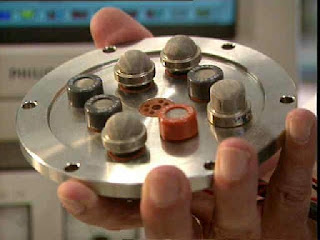For years, the idea of artificial intelligence has been seen
everywhere from national news to sci-fi conventions. We’ve all seen trailers
for movies like I, Robot and A.I. Artificial Intelligence, and many
have wondered if the human imagination (and a little bit of science) could
create a robot that is superior to ourselves. Robots can already do everything
from play the violin to bartend, and new innovations are being born every day.
Regardless of the advances in technology we see, I have to ask myself: Will
robots ever compare to humans?
The reason for my questioning might come as a surprise…it
has to do with the sense of smell and the creation of the electronic nose. Dr.
Michele Gregorkiewitz, of the University of Siena, works with microporous and
mesoporous membranes, which are porous solids with pore sizes between 2 and 50
nanometers. The tiny holes in these membranes can be used for many purposes,
but my favorite has to be as chemical sensors to detect smell. Did you catch a
whiff of that? They can recognize smells.
Now,
the human nose has about 5 million olfactory receptors
and is able to recognize some 10,000 different types of smells (Alabama
A&M
and Auburn University). That seems like a lot for this device to match
up to. However,
the sensors in an electronic nose are receptive to the same types of
chemicals
that the human nose can sense. In the commercial market, electronic
noses can
have over 100 sensors with individualized responses.
Each of these sensors has a high response to specific chemical compounds, but will also respond to a
wide variety
of other chemicals as well, leading to sensory overlap and the detection of
tiny differences between similar smells (Iowa State University). Can you
smell the difference between
a dairy farm and a pig farm? Our noses have the ability to distinguish between these differences, but we'd probably just classify both as unpleasant. The
electronic nose can distinguish between them and help us determine the exact chemical differences in the smells.
While they certainly don’t look like human noses, the
electronic kind have already been integrated into product development and
quality control for many industries, such as beverage, food, and perfume. They
can detect the types of aromas you should and shouldn’t find in wine and olive
oil, and they can interpret this information into a graph showing what
those scents say about the quality of the product. While the trained human nose
may still be better at this type of quality control, I have to admit that the
artificial nose does a pretty good job of imitating it.
Electronic Nose Sensors
It’s amazing, but in the end I have to conclude that robots
and electronics will never be quite as amazing as humans. Why? Because the
human body is a myriad of functions, formations, and mysteries that we might
never fully understand. Because every idea for a robot has come out of the mind
of a human being, proving that a simple idea can turn into reality. Because
even though we’re able to mimic and manipulate the biology of the body in a lab
setting, the human being is more than just a network of chemical and biological
responses. We’re more than just elements on a table, and definitely more than
just a brain.
Non-artificial intelligence. Wins every time.
Resources:
http://www.aces.edu/pubs/docs/U/UNP-0066/UNP-0066.pdf
http://www.extension.iastate.edu/Publications/PM1963C.pdf
http://www.chim.unisi.it/Emory_Unisi/2010/DidacticMaterials_file/MicheleGregorkiewtz_Presentation_03June2010.pdf

No comments:
Post a Comment